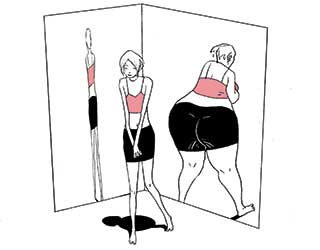
Illustration: Istvan Banyai
In 2006, the surgeon general called obesity “the terror within” and said it could “dwarf 9/11 or any other terrorist attempt.”
A recent anti-obesity ad campaign featured a “suicide bomber” with bars of butter strapped to his chest.
A 2002 study found that 13% of men and 17% of women of recruitment age are too fat to serve in the military.
In 1997, the World Health Organization teamed up with the International Obesity Task Force to redefine obesity standards. “Overweight” was defined as a body mass index (bmi) of 25 or more, down from 27.8.
70% of the Obesity Task Force’s funding comes from the two drug companies that make the popular weight-loss pills Xenical, Meridia, and Reductil.
In 1998, the US government adopted the new bmi standards, spurring fears of an “obesity epidemic.”
That move was hailed by the American Obesity Association, a lobbying group that’s received funding from Weight Watchers and Jenny Craig.
Sarah Hartshorne, a “plus size” contestant on America’s Next Top Model, has a bmi of 21.5—well within the “normal” range.
Recent studies have attributed obesity to low-fat foods, lack of sleep, ear infections, intestinal bacteria, pollution, plastics, poverty, air conditioners, socializing with obese people, your mom’s age when you were born, and your maternal grandmother’s diet.
Researchers say obese Americans contribute disproportionately to global warming by consuming 18% more food and 938 million extra gallons of gas every year.
Southwest Airlines requires customers “who compromise any portion of adjacent seating” to buy 2 seats.
People who weigh more than 220 lbs are 150% less likely to survive a car crash than those under 130 lbs.
All 157 West Virginia public middle schools use the video game Dance Dance Revolution in gym classes.
Schools in Pennsylvania, Delaware, South Carolina, and Tennessee send “obesity report cards” to parents.
One Pennsylvania school district that does so serves pizza and churros for breakfast.
The federal government’s list of banned foods in school cafeterias doesn’t include fries, candy bars, or chocolate chip cookies.
In 2005, Sesame Street changed Cookie Monster’s theme song from “C Is for Cookie” to “A Cookie Is a Sometime Food.”
In 2005, British doctors said a 15-year-old who’d eaten only jam sandwiches and Pop-Tarts since he was 4 was totally healthy, except for an iron deficiency.
A 2008 study on “brideorexia” found that 70% of brides-to-be try to lose weight. Almost 1/4 try fasting, pills, or laxatives.
First-time users of Alli, a new over-the-counter fat-blocking pill, are advised to “wear dark pants, and bring a change of clothes with you to work.”
People consume an average of 28% more calories when eating snacks labeled “low fat,” in part because they mistakenly think they’re eating fewer calories.
In 2007, T.G.I. Fridays rolled out a “Right Portion” Cajun pasta dish with 4 times more fat than the usda‘s daily recommendation.
People served soup in bowls that secretly refilled ate 73% more than those eating from normal bowls. But they felt just as full afterward.
The “Diet Fork” has dull teeth and an uncomfortable grip that force eaters to “scoop less.”
“Diet glasses,” whose blue tint makes food look less appealing, were big in Japan last year.
Gwyneth Paltrow, Madonna, and Christina Aguilera wear $250 sneakers by Masai Barefoot Technology, which claims they burn cellulite.
The net worths of white women whose bmis fall 10 points increase by an average of $11,800.
Loss Leaders
Kick back, relax, and let these products melt the pounds away.
what: Fabuless
slims by: Downing a concoction of palm and oat oils slows digestion and produces a feeling of fullness, reducing caloric intake nearly 1/3.
the skinny: Some users report feeling bloated.
what: Conjugated linoleic acid
slims by: Promoting lean muscle growth
the skinny: Has been linked to type 2 diabetes
what: Nutraproteomics diet
slims by: Basing diet advice on your genetic makeup
the skinny: A dna test costs $525.
what: Soybean hulls
slims by: Decreasing fat in fried foods by as much as 36% without hurting “flavor, crispiness, or general liking”
the skinny: Fried foods still loaded with fat.
what: Rebiana sweetener
slims by: Has no calories
the skinny: This derivative of the stevia shrub has caused cancer and blocked sperm production in lab animals.
Christian weight-loss books include What Would Jesus Eat? and More of Jesus, Less of Me.
25 minutes of daily Islamic prayers burns 80 calories.
ChastitySF.com, a Catholic site, tells dieters to imagine a “Purgatory where every unnecessary mouthful of food you have ever taken will be purged from you as flaming vomit.”
Liquids account for 22% of the average American’s daily calories.
After New York City made eateries post nutritional data, a survey found that 80% of diners were surprised that a Big Mac meal had 1,200 calories.
A recent Burger King commercial included the line, “I will eat this meat until my innie turns into an outie.”
Last year, a Republican Mississippi state legislator proposed prohibiting restaurants from serving obese people.
Researchers asked 3,000 overweight people how they responded to discrimination; 79% said they ate more.
Active obese people are almost 50% less likely to die of heart disease than sedentary thin people.
Playboy Playmates of the Year selected during tough social and economic times are heavier and have larger waists.
When the Dow lost nearly 778 points in one day last September, every S&P 500 company went down—except Campbell’s Soup.
Related articles: Exhibit Sources








